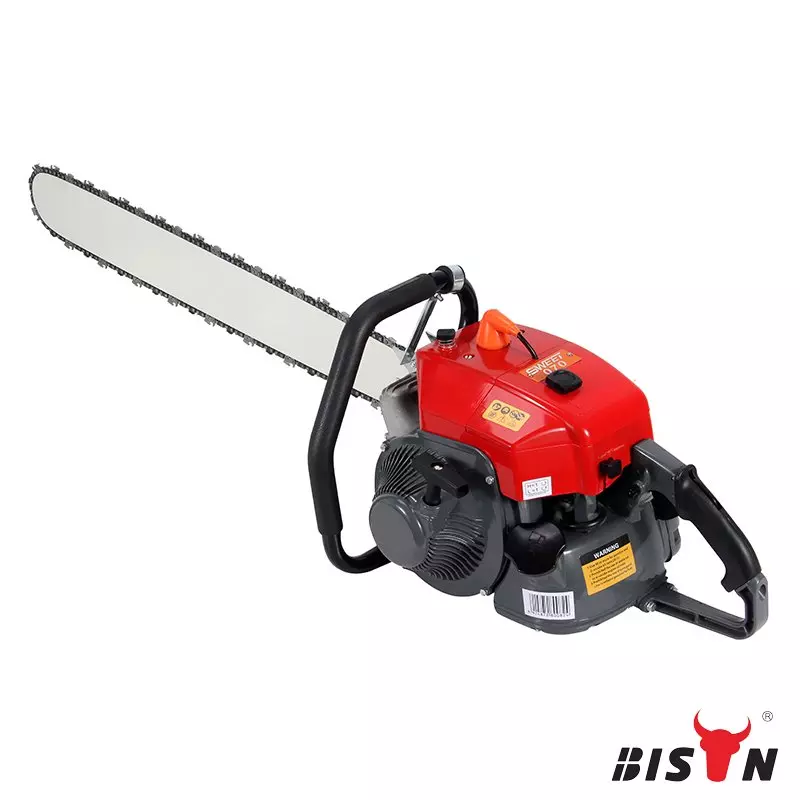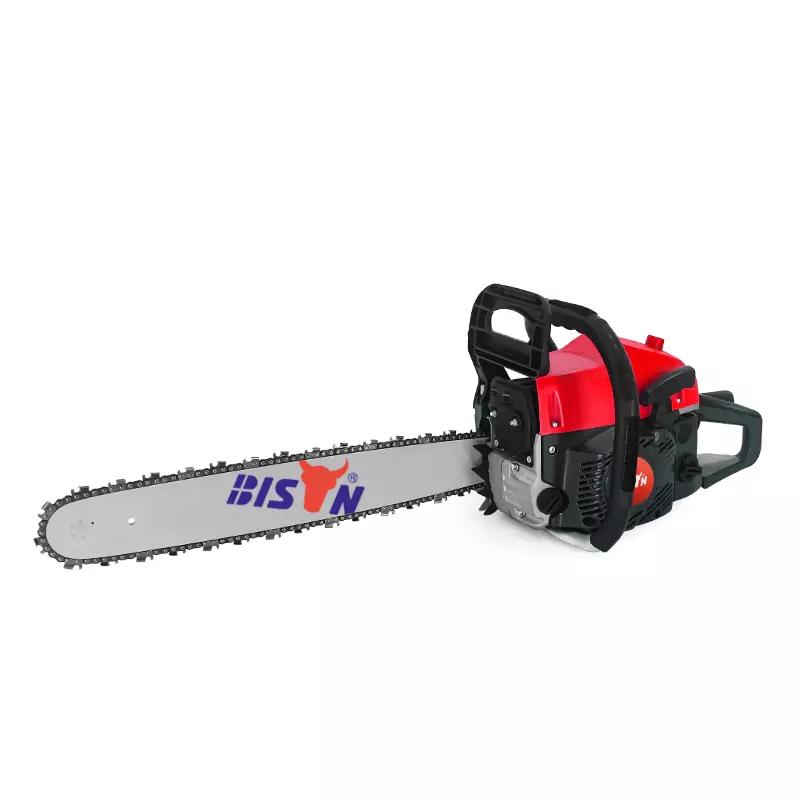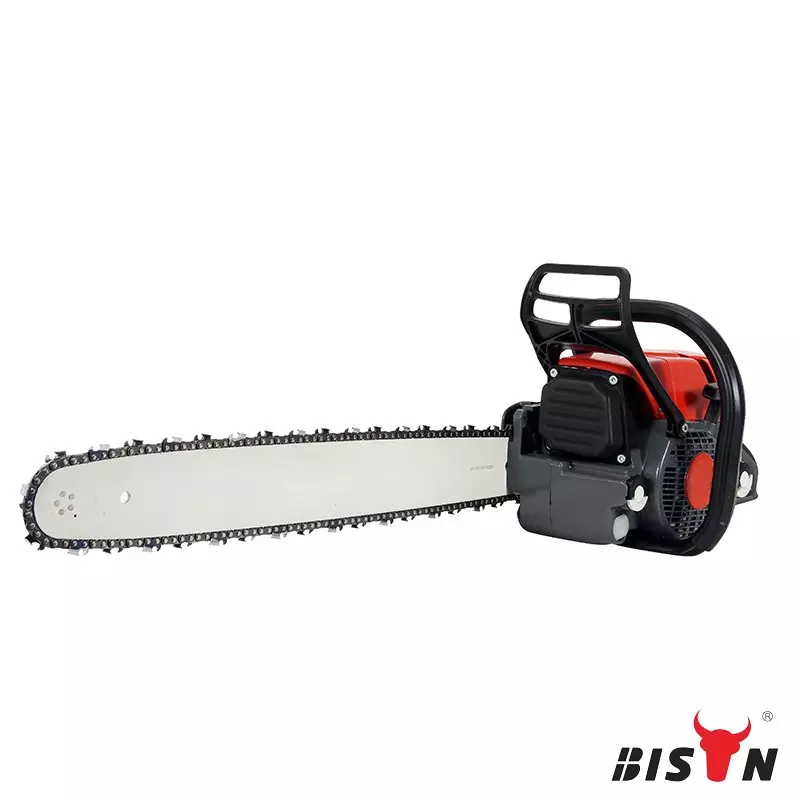perfecting your purchase: how to choose right chainsaw size
2023-11-21
Table of content
When it comes to outdoor power tools, a chainsaw is perhaps one of the most versatile and impactful. However, the choice of a chainsaw size significantly affects its cutting ability and portability. How do you know which one is the right fit for you?
In this article, BISON will delve into the world of chainsaws, helping you understand what 'chainsaw size' means and how it impacts a chainsaw's performance. We'll discuss the factors you should consider when choosing the size of a chainsaw. Below is the answer to "How to choose the right chainsaw size?" and other vital questions.

Understanding chainsaw sizes
When we talk about the 'size' of a chainsaw, we're referring to the guide bar length. The guide bar length is the long metal part that guides the chain, and its length directly correlates with the size of the trees or branches you can cut. In simple terms, the longer the guide bar, the larger the tree diameter it can handle. But remember, a longer bar also means more weight and potentially more difficulty in handling the chainsaw, especially for extended periods.
A chainsaw that is the right size does the job well and is comfortable for you to work with. It saves you time, money, and a lot of frustration.
You can choose the right chainsaw size for your job with the tips below. If you're purchasing a chainsaw for a specific project, ensure it can handle it. Also, consider the type of work you typically use it for so that your chainsaw is the right size for all of your projects.

Small Chainsaws (8 to 14-inch bar length)
On the smaller side, BISON have chainsaw chain sizes ranging from 8 inches to 14 inches. These chainsaws are perfect for light-duty tasks such as pruning small branches and shrubs. They are lightweight, easy to maneuver, and ideal for beginners or those who only occasionally need a chainsaw.
8" chainsaw
Best for small limbs with a diameter of 6" or less. This is often used for trimming or small branch work. Many of these are electric or battery-powered because they are small and don't require a lot of power. 8-inch chainsaws are generally very easy to operate for those new to chainsawing.
10-inch chainsaw
A 10-inch chainsaw is best for cutting up to 8 inches in diameter. These are mainly smaller limbs and branches. Most of these saws are battery-powered but may also be fuel-powered. For new or novice users, they are still within range.
Medium Chainsaws (16-18 inches)
Medium-sized chainsaws offer a balance between power and portability. They're suitable for cutting medium-sized trees and chopping firewood. If you have a fireplace and need to regularly cut firewood, this could be a good choice for you.
16-inch chainsaw
This is great for felling small trees or chopping off larger branches. It easily cuts wood up to 14 inches in diameter. This larger saw is usually gas-powered, but you can still find different options to suit your needs.
18-inch chainsaw
The 18" chainsaw sits on top of the "medium" chainsaw. It's also one of the most commonly purchased sizes due to its versatility. It's large enough to handle cuts up to 16 inches in diameter while still being manageable for small cuts. Many homeowners and DIYers use this size saw for many types of cuts.
This range of bar lengths is perfect for most jobs you'll be doing. While they can't handle huge trees or branches, they can handle most of the things you'll do around the house.
Large Chainsaws (18-24 inches)
These chainsaws are designed for heavy-duty tasks like felling larger trees and are typically used in professional applications like logging and arboriculture. They pack more power but are heavier and require more experience to handle safely.
20-inch long bar
A 20" long cutting bar is available for more significant job categories. You can cut through an 18" tree with a chainsaw this size. It's also great for splitting extensive logs in half or quarters.
Chainsaws with cutting bar lengths of 20 inches or more are serious machines. They have powerful motors and are designed for long-term, heavy-duty use. Most of these saws are gas-powered due to the power requirements, but other options still exist. They require care and experience to handle. Chainsaws can be dangerous if you don't know what you're doing.
Extra Large Chainsaws (24 inches and above)
The giants of the chainsaw world, are designed for the most demanding jobs, such as milling and felling very large trees. Extra large chainsaws are primarily used by professionals and require considerable experience and strength to operate safely.
Factors to consider when choosing chainsaw size
Choosing the right chainsaw size is not a one-size-fits-all decision. It requires careful consideration of several factors, ranging from the purpose of use to your personal experience and skill level. These factors and many others can help you choose the ideal chainsaw, especially if you have multiple projects. Let's delve deeper into these factors:
Purpose or use: The task you intend to accomplish with your chainsaw largely determines the size you should go for. Do you want to cut some branches off the tree? Are you cutting large logs or whole tree trunks? For light tasks such as pruning small branches or cutting small trees, a small chainsaw (10-14 inches) is typically sufficient. If you plan to fell medium-sized trees or cut firewood regularly, a medium-sized chainsaw (14-18 inches) would be more appropriate. For heavy-duty tasks like felling large trees, you'll need a large (18-24 inches) or extra-large chainsaw.
Experience level and skills: Handling a chainsaw requires skill and experience. Larger chainsaws pack more power but can be challenging and potentially dangerous for beginners to operate. If you're new to using chainsaws, starting with a small or medium-sized chainsaw can be a safer choice. As you gain more experience and confidence, you can then consider moving up to larger sizes.
Weight and balance: The size of a chainsaw directly affects its weight and balance. Larger chainsaws are heavier, which can make them difficult to handle, especially when used for extended periods. Moreover, maintaining control of a heavy chainsaw is crucial for safety. Therefore, it's important to choose a chainsaw size that you can comfortably manage and control.
User experience: Your comfort and ease while using the chainsaw are also important considerations. If a chainsaw feels too heavy or unwieldy, it can lead to fatigue and increase the risk of accidents. Therefore, when choosing a chainsaw size, consider your physical capabilities and comfort level.
Conclusion
Choosing the right chainsaw size is a crucial decision that influences not only the efficiency of your work but also your safety. The perfect chainsaw for you depends on the nature of your tasks, your experience level, and your physical capabilities. From light pruning to felling large trees, each task calls for a different size chainsaw to get the job done effectively and safely.
Remember, a small chainsaw might struggle with larger tasks, making your job harder than it needs to be. On the other hand, a chainsaw that's too large or powerful can be challenging to control, especially if you're a beginner, increasing the risk of accidents.
As you consider your chainsaw size options, reflect on your specific needs and your own abilities. Don't overestimate what you can handle safely. It's always better to start small and work your way up as you gain more experience and confidence.

Your trusted chainsaw manufacturing partner
As you start the business of chainsaws, it's essential to have a reliable, knowledgeable, and professional partner by your side.
We are BISON, a leading chainsaw factory based in China. Our commitment goes beyond providing quality products. We also offer personalized advice to you, ensuring you have the right information and support to make informed decisions. With our team of experts, we can guide you through our product range, help you understand the unique features and benefits of each model, and assist you in choosing the chainsaws that best meet your customers' needs.
It's time to power up your chainsaw business with BISON. Reach out to us today!



